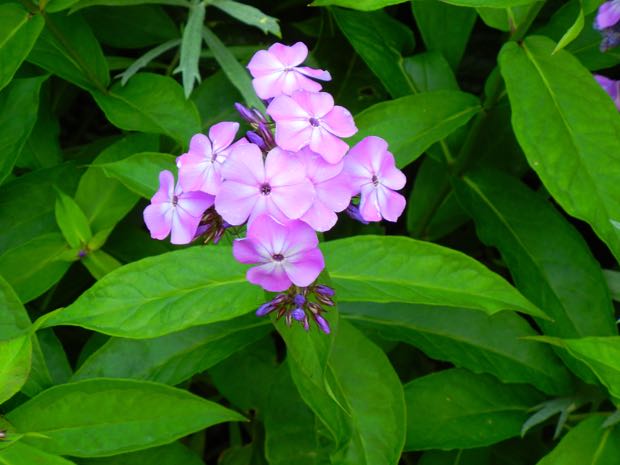Phlox paniculata ‘Little Boy’: A Burst of Color and Fragrance
Phlox paniculata ‘Little Boy’, also known as Garden Phlox, Fall Phlox, Perennial Phlox, or Summer Phlox, is a captivating herbaceous perennial that adds vibrant hues and a delightful fragrance to any garden. Belonging to the Polemoniaceae family of plants, this variety is native to the Eastern and Central United States as well as Eastern Canada. Its alluring flowers attract birds, hummingbirds, and butterflies, creating a lively and dynamic ecosystem.
Exquisite Beauty and Growth Habits
With its spreading habit of nearly 1m or 39in, Phlox paniculata ‘Little Boy’ forms an impressive display of lance-shaped leaves. Its distinct panicles, from which it derives its name “paniculata,” bear clusters of fragrant lilac flowers with captivating white centers. These blossoms grace the garden with their presence throughout the summer and autumn seasons. To encourage prolonged flowering, regular deadheading is recommended. While Phlox can present some challenges in cultivation due to susceptibility to powdery mildew and pests, its stunning blooms make the effort worthwhile.
How to grow Phlox paniculata ‘Little Boy‘:
Cultivating Phlox paniculata ‘Little Boy’: A Comprehensive Guide
Sun and Soil Requirements
Phlox paniculata ‘Little Boy’ thrives in a location that receives ample sunlight or partial shade. Aim for at least six hours of direct sunlight each day to promote optimal growth and abundant blooms. When selecting a planting site, ensure the soil is moist, well-drained, and rich in organic matter. Phlox appreciates humus-rich soil, so incorporating compost or well-rotted manure prior to planting will provide the necessary nutrients for vigorous growth.
Planting and Watering
Planting: Dig a hole that is slightly larger than the root ball of your Phlox paniculata ‘Little Boy’ plant. Place the plant in the hole, ensuring that the crown is level with or slightly above the soil surface. Backfill the hole with soil, gently firming it around the roots to eliminate any air pockets.
Watering: Adequate moisture is crucial for the health and vitality of Phlox paniculata ‘Little Boy.’ Water the plant deeply immediately after planting to settle the soil and encourage root establishment. Thereafter, maintain regular watering to keep the soil consistently moist. Aim to provide about an inch of water per week, either through rainfall or supplemental irrigation. Avoid overwatering, as excessive moisture can lead to root rot and other fungal diseases.
Mulching and Fertilizing
Mulching: Apply a layer of organic mulch, such as wood chips or compost, around the base of the plant. Mulching helps to conserve soil moisture, suppress weed growth, and regulate soil temperature. Keep the mulch a few inches away from the stems to prevent excessive moisture retention, which can promote disease development.
Fertilizing: Phlox paniculata ‘Little Boy’ benefits from regular fertilization to support robust growth and abundant flowering. Apply a balanced, slow-release fertilizer in early spring when new growth emerges. Follow the manufacturer’s instructions for the appropriate dosage and method of application. Additionally, a side-dressing of compost or well-rotted manure in early summer can provide an organic boost of nutrients.

Maintenance and Disease Management
Deadheading: To encourage prolonged blooming and prevent the plant from expending energy on seed production, regularly remove spent flowers by deadheading. Trim the flower stalks just above a set of healthy leaves or a lateral bud to stimulate new growth and the development of additional blooms.
Powdery Mildew Prevention: Phlox paniculata ‘Little Boy’ can be susceptible to powdery mildew, a fungal disease that appears as a white, powdery coating on the leaves. To minimize the risk, provide adequate air circulation by spacing plants appropriately and avoiding overcrowding. Water the plant at the base rather than overhead to keep the foliage dry. If necessary, apply a fungicidal spray labeled for powdery mildew control according to the manufacturer’s instructions.
Pest Management: Monitor your Phlox paniculata ‘Little Boy’ for common pests such as aphids, which can distort new growth and reduce plant vigor. If aphids are present, you can employ natural control methods such as spraying the plant with a strong stream of water or introducing beneficial insects like ladybugs. Alternatively, use an insecticidal soap or neem oil spray, following the instructions carefully.
Propagation and Division
Phlox paniculata ‘Little Boy’ can be propagated through division, which helps rejuvenate the plant and create new individuals. Follow these steps to divide your established Phlox:
- In early spring or early autumn, carefully dig up the plant, ensuring you preserve as much of the root system as possible.
- Gently separate the clumps into smaller sections, ensuring each division has several healthy stems and a portion of the root system.
- Replant the divisions in prepared soil, ensuring they are at the same depth as they were previously.
- Water the newly planted divisions thoroughly to settle the soil and promote root establishment.
- Continue to care for the divided plants following the same guidelines for sun exposure, soil moisture, and maintenance as outlined earlier.
- By following these cultivation tips and guidelines, you can successfully grow and enjoy the vibrant blooms of Phlox paniculata ‘Little Boy’ in your garden. With proper care, this perennial plant will reward you with its stunning flowers and attract butterflies while adding beauty and color to your outdoor space.

Also, read Phlox paniculata ‘Rosa Pastell’ which is another variety of Phlox paniculata.



